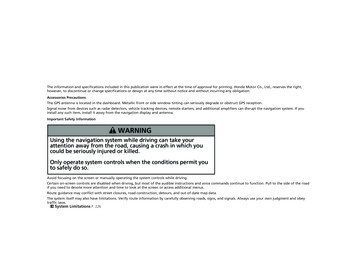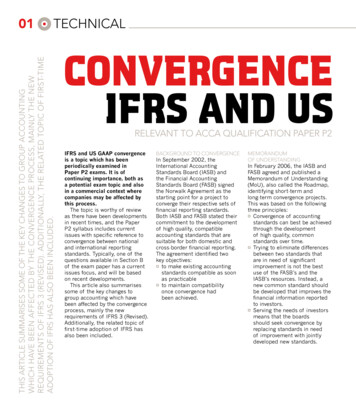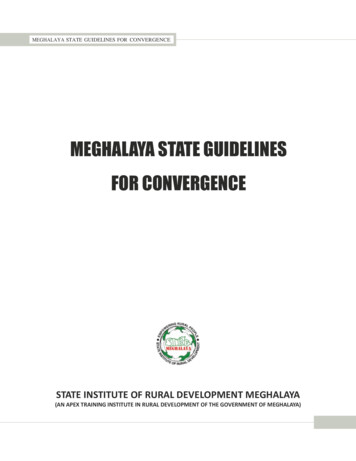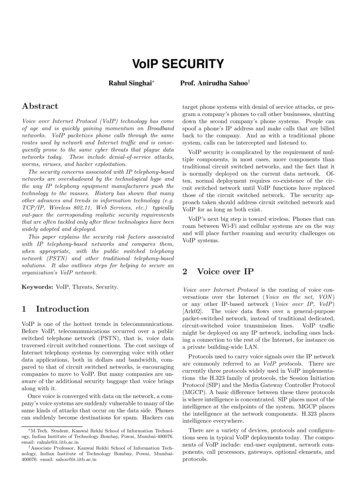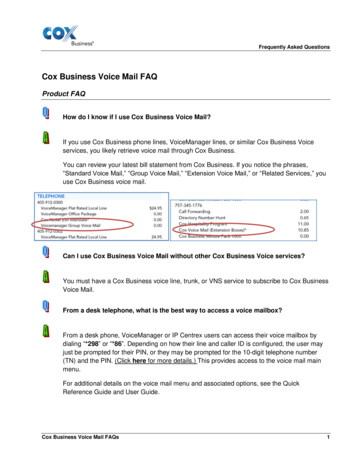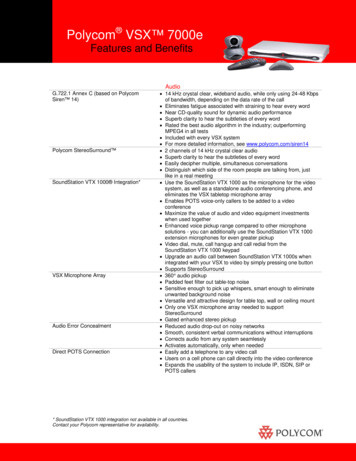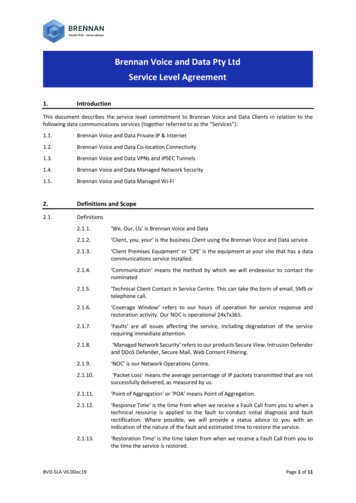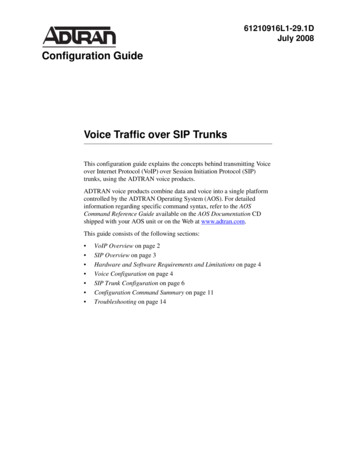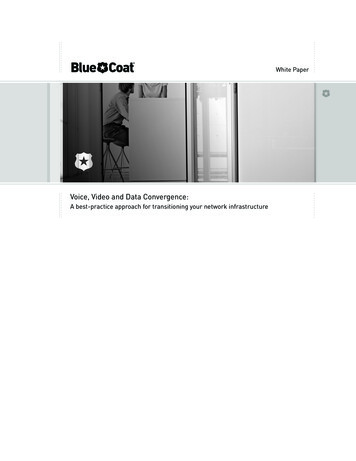
Transcription
White PaperVoice, Video and Data Convergence:A best-practice approach for transitioning your network infrastructure
Voice, Video and Data ConvergenceThe business benefits of network convergence are clear: fast, dependable,real-time communication, unprecedented information mobility and workerflexibility, and the ability to instantly transmit a variety of data types toalmost any device, anywhere in the world. And that’s just the beginning.Not surprisingly, enterprises everywhere want to quickly prepare their ITinfrastructure to take full advantage of convergence. Is your company oneof them? If so, you need a strategy that helps you quickly achieve thesebenefits, with minimal investment and impact to your business processes.This white paper is a great place to start.Building the right convergence strategy for youTo successfully transition to a converged network, you must have theappropriate IP telephony applications, system components and bandwidth tomanage voice and video communication. The following six questions can helpyou assess your current infrastructure and determine how to deliver the richfunctionality business users demand without compromising network securityor performance.Question 1: Is your network ready for IP telephony?The first step in assessing network readiness is determining whether yourcurrent bandwidth can support future VoIP deployments. If not, can youborrow bandwidth from less critical applications, or will you have to addcapacity? Second, what will be the impact to your existing applications?You need to ensure your existing networks and the service levels establishedfor data traffic can support the additional demands placed on them byIP telephony.Question 2: Can your data and IP telephony traffic co-exist on your network?If left unchecked, the additional bandwidth required for voice and videotraffic on a converged network will impact the performance of businessapplications whose data shares that bandwidth. But you don’t necessarilyneed to purchase new bandwidth to deliver it all. By prioritizing your appli cations, you can make room for latency-sensitive business applications, suchas SAP or Oracle, as well as the new voice and video traffic.2
Voice, Video and Data Convergence:To ensure optimum performance, you need to distinguish between essential,non-essential and harmful traffic on your network such as:- B andwidth-hungry applications (sometimes called bursty) like e-mail, filetransfers, backup and distributed storage- T ime-sensitive applications that use voice and video- R ecreational or malicious trafficTo identify the difference between business and non-business activity, yourinfrastructure solution must enable you to:- A pply partitions and policies to protect critical applications and contain orblock recreational and malicious traffic.- Use bandwidth management to smooth bursty traffic and reduce end-toend congestion, improving overall network performance and efficiency.- T ake advantage of session guarantees, which will ensure the performanceof video and voice applications.Question #3: Do you have enough network visibility to ensure consistent voiceand video performance?To evaluate your current voice and video traffic and calculate your futurerequirements, measure your current bandwidth usage and determine howmany concurrent users you want to support. You can establish a roughestimate of your bandwidth requirements by multiplying the number ofusers by the amount of bandwidth measured. For voice, ten concurrentsessions at 25Kbps each would equal about 250Kbps in each direction.For video, a 384 codec may require two concurrent sessions of 420Kbpseach (headers and control information are included).If you’re not sure how to generate these metrics, consult with a solutionsprovider with proven expertise in this area. Either way, don’t skip thisstep — it’s absolutely critical to insulating your budget from unanticipatedbandwidth expenditures down the road.Question 4: Can you differentiate between sanctioned and unsanctioned voiceand video traffic?Bandwidth-intensive voice and video traffic originates from many typesof recreational applications, and poses an increasing threat to networkperformance — even in large organizations. If your company relies on3
Voice, Video and Data ConvergenceIP telephony to support critical business activities, you need a way todifferentiate between sanctioned and unsanctioned voice and video traffic.Your infrastructure solution must be able to discover and monitor each ofthese applications before you can separate and control potentially disruptivetraffic from the legitimate voice and video communicationsyour business relies on.Question 5: Can you minimize jitter, delay and packet loss?Jitter, delay and packet loss can cause significant degradation in quality andoverall reliability in real-time services. Here’s why:- J itter causes unpredictable and variable delays in the delivery of eachvoice packet.- D elay is the end-to-end latency in delivering the voice stream from thespeaker to the listener.- P acket loss drops individual packets when the network is too congested.Together, these disruptions can take an entire service offline. To protectand optimize voice traffic, your infrastructure solution should be able tomonitor key metrics designed specifically for real-time protocol (RPT) trafficlike IP telephony, including R-Factor and Mean Opinion Score (MOS), andprovide alarms to signal performance degradation and automate preemptivetroubleshooting. Finally, to accelerate voice and video traffic across yournetwork, you should use only application-aware protocol accelerationtechnology to ensure that bandwidth is not wasted on non-essentialrecreational applications.Without these controls, you can’t determine what to accelerate and whatto block or sequester. As a result, acceleration without control can actuallyincrease latency 50-100%, increase jitter to 140ms and almost double yourpacket loss. To avoid these problems, you need to differentiate betweenapplications.Question 6: Can you handle a rapid increase in network traffic withoutadding bandwidth?Network convergence has many proven benefits, but increased voice and videotraffic also puts additional pressure on the network. While it can be temptingto simply add more bandwidth to address slow performance, this approachis both costly and ineffective. Many recreational and peer-to-peer (P2P)4
Voice, Video and Data Convergenceapplications will actually consume any additional bandwidth they encounter,so this approach rarely improves business application performance.To maximize available bandwidth for legitimate transactions and discouragerecreational traffic the best approach is to integrate compression andcontrol capabilities. Combining compression and control can help preventrecreational traffic from dominating bandwidth while allowing acceptablelevels of access to these sites and applications.Blue Coat: A comprehensive solution for video andvoice convergenceBlue Coat offers a comprehensive solution to ensure your critical businessapplications get the bandwidth they need to perform at their peak. Byintegrating visibility, acceleration and control technologies, Blue Coat helpsyou see everything on your network, monitor for potential performanceissues and accelerate business applications while controlling recreationaluse. Best of all, you can make the most of your existing infrastructure andavoid expensive investments in additional bandwidth.See how data flows across your networkBlue Coat helps you safely determine how to optimize data flow across yournetwork. You can test-run voice calls or video conferences to measure thebandwidth needed to support each of these activities during times of peakdemand or when there is little competition on the network. You can thendetermine an appropriate minimum and maximum amount of bandwidthneeded for voice and video traffic.You can also establish service-level reporting to set thresholds and measurecompliance. Simply set performance thresholds against a known set ofquality metrics, and configure Blue Coat to proactively send alerts or reactimmediately. For example, you can reduce bandwidth for applications thatare not time- or business-critical when thresholds are reached.Monitor your network for performance bottlenecksIn a converged network, VoIP traffic and business applications often competefor bandwidth, creating performance problems for both. With Blue Coat,you can determine where and how to allocate bandwidth to ensure optimumperformance for all your business transactions.5
Voice, Video and Data ConvergenceBlue Coat simplifies this allocation process by helping you identify, classifyand monitor all the applications on your network. For instance, you canseparately group time-critical applications such as voice and video, businessprocesses like SAP and Oracle, bandwidth-intensive applications such asemail and file transfers, and non-essential recreational traffic that can clogyour network. Once you classify these applications, you can then prioritizehow to manage them according to their business impact.Accelerate with controlReal-time business communication depends on a highly secure andoptimized network. To ensure adequate bandwidth and quickly moveapplications across your network, you have to distinguish between eachapplication and even between different types of voice and video traffic.Blue Coat delivers the right combination of acceleration and control to getthe right content to the right people at the right time, even when networkdemand is at its peak. Here’s how:Manage spikes in network usageOn any WAN, there is a finite amount of bandwidth. So when demandspikes threaten your business applications you need to intervene andensure that business activity, such as voice calls and video sessions,remain uninterrupted.Blue Coat helps you easily allocate bandwidth during times of peak demand.You can set a rate policy on each of your voice and video data classes (RTP orothers) to:- Indicate the relative importance of voice and video traffic and distributebandwidth accordingly.- I nsulate voice and video users from each other to gain the benefits ofrate control.- Reduce retransmissions that waste bandwidth and introduce latency.- Guarantee bandwidth on a per-session basis.Blue Coat allows you to assign a rate of minimum bits-per-second requiredto deliver acceptable voice call or video session quality. But you don’t simplyprioritize voice and video over other business activity. With Blue Coat, you areable to maintain expected service levels for all business-critical applications.6
Voice, Video and Data ConvergenceDistinguish between personal and professional useRecreational voice and video applications, such as Skype and IM, arealmost as commonly used as email. But these bandwidth-intensiveapplications can tie up even the highest bandwidth links. So if your companyrelies on IP telephony for business communication you need to know whenit’s being used for business or personal reasons.With Blue Coat, you can manage voice and video applications by monitoringthe network to control recreational use and proactively block malicioustraffic before they disrupt the performance of critical business applications.You can then apply granular policies to distinguish between essential voiceand video use and non-essential traffic and allocate bandwidth to supportquality-of-service (QoS) requirements.Recognize and resolve MPLS limitationsIf you are using an MPLS-based IP subscription, you need to assignvoice and video with real-time priority classes of service. However, thereare limitations in the queuing and packet-based QoS features inherentin MPLS.For example, if you provision a class of service for four calls, eachpacket of each of these four calls will be given the highest priority. In anoversubscription situation — such as too many calls in a class of service —the network subscription will process more of that class of traffic than it cansupport. So when calls 5, 6 and 7 occur, all packets are downgraded to a lowerclass of service category. As a result, all calls suffer a reduction in quality.Recognizing this limitation, Blue Coat allows you to integrate with MPLSto control traffic and route each transaction into the proper service classacross your MPLS network connection. So real-time voice and video trafficthat requires immediate bandwidth is tagged with the correct MPLS class,but only after Blue Coat has managed traffic at the flow level to preventoversubscriptions.When you assign an MPLS label to ensure special traffic gets the prescribedperformance, you can also configure Blue Coat to classify the trafficseparately. Then you can apply analysis techniques or assign partitions orpolicies to each class to control performance.7
Voice, Video and Data ConvergenceMeasure for qualityBlue Coat helps you monitor and control voice and video performancethroughout your distributed enterprise by establishing service guaranteesfor every user regardless of location. Blue Coat delivers detailed reportson critical factors for real-time data flows, including MOS, R-Factor,jitter, delay and more. You can also configure performance thresholdsfor each session to ensure you’re meeting designated service levels.More importantly, you get real-time alerts when performance levels arethreatened so you can automatically respond to competing demands forbandwidth. By continually measuring and monitoring network performance,Blue Coat helps you proactively resolve problems before they impact yourusers and your business.Key factors for reporting on real-time data flows like voice and video traffic.8
Voice, Video and Data ConvergenceDeliver the service and quality yourusers expectWith Blue Coat, you can seamlessly transition to a converged network withsolutions that help you plan and execute the right strategy for your business.Our goal is to help you quickly achieve the benefits of convergence withminimal impact during all the stages of execution.To start the transition process, Blue Coat provides the intelligence you needto optimize essential business applications, including time-sensitive voiceand video transactions. Our solutions help you establish and enforce servicelevels for quality and availability, and give you the tools to anticipate andresolve network problems before they impact your end user.More specifically, Blue Coat helps you measure jitter, loss and delay forRTP traffic so you can better monitor call quality for IP telephony and videoconferencing. You can also leverage monitoring and reporting tools to betterunderstand and manage bandwidth usage across your network. The result isa successfully converged network that delivers the highest level of security,acceleration and control for your business.About Blue Coat: Blue Coat Application Delivery Network solutions provideintelligent control with visibility, acceleration and security technologiesthat optimize application and network performance for any user, anywhere,across a distributed enterprise. Blue Coat’s application performancemanagement, WAN optimization and Secure Web Gateway solutions enableIT to provide greater business efficiency, effectiveness and competitiveness.Additional information is available at www.bluecoat.com.9
Blue Coat Systems, Inc. 1.866.30.BCOAT 1.408.220.2200 Direct 1.408.220.2250 Fax www.bluecoat.comCopyright 2008 Blue Coat Systems, Inc. All rights reserved worldwide. No part of this document may bereproduced by any means nor translated to any electronic medium without the written consent of Blue CoatSystems, Inc. Specifications are subject to change without notice. Information contained in this document isbelieved to be accurate and reliable, however, Blue Coat Systems, Inc. assumes no responsibility for its use,Blue Coat is a registered trademark of Blue Coat Systems, Inc. in the U.S. and worldwide. All other trademarksmentioned in this document are the property of their respective owners.
ensure that business activity, such as voice calls and video sessions, remain uninterrupted. Blue Coat helps you easily allocate bandwidth during times of peak demand. You can set a rate policy on each of your voice and video data classes (RTP or others) to:- Indicate the relative importance of voice and video traffic and distribute
